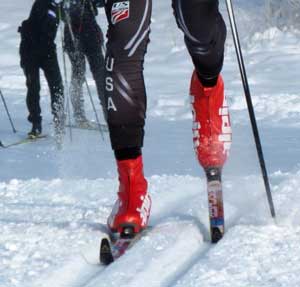
Glide waxing for very cold conditions
Thu, Feb 7, 2013 - By Ian Harvey
 After considering a ski's flex and structure, wax is critical to having good skis in cold conditions. The most basic aspect to cold waxing is that the base needs to be hardened a lot. This means that it needs a couple layers of a very hard glide wax such as LF Blue ironed in. This both makes the skis faster as well as makes the wax job more durable.
After considering a ski's flex and structure, wax is critical to having good skis in cold conditions. The most basic aspect to cold waxing is that the base needs to be hardened a lot. This means that it needs a couple layers of a very hard glide wax such as LF Blue ironed in. This both makes the skis faster as well as makes the wax job more durable.
Additionally the wax selection needs to be good. If conditions are cold and slow, it is best to mix in XCold powder with the glide wax of the day (HF Blue usually). This makes the skis climb and accelerate better. If conditions are simply cold and pretty fast, straight HF Blue is generally best. If conditions are really fast despite the cold, usually it provides a super high end speed to mix in a bit of HF Yellow (or AX134) with HF Blue. Only do this if it is really fast as, if it isn't, breakaway speed, which is very important for climbing, will be sacrificed.
Application method is also critical. One persistent "tip" that has been circulated since the mid 80s when synthetic additives began to be added to cold glide waxes is to scrape the skis when they are still warm. This whole idea started because people were trying to avoid getting sharp pieces of wax in their eyes, not because they wanted fast skis. This is definitely bad advice. It is very important to let the wax cool to room temperature before scraping. Furthermore, if cold hard waxes are "springing" off the skis, when you are scraping them, it is because they weren't exposed to enough heat when being ironed and there is air between the ski base and the wax. This results in a slow and not durable wax job. The combination of time and temperature needs to be enough to ensure a good bond between the wax and the base. If the wax comes off like very fine sawdust, it was heated in enough.
Also regarding application method, topcoats such as JetStream Blue are much faster in cold snow if they are rotocorked rather than ironed. It is also effective to do a "quick iron" job with a very hot iron and a fast pass (10 seconds) and then rotocork over it, but to do a full on iron job where the ski base is jet black behind the iron makes for a "sticky base" in cold powder snow. It is definitely faster to rotocork or "quick iron" and then hand cork. This is not a Toko thing, but applies to all brands.
The best brush for brushing out cold hard glide waxes is the Horsehair Brush because it is both stiff and fine. Use the Nylon Polishing brush for brushing out JetStream waxes.
In cold snow that is also very slow, an advanced technique is to follow HF Blue/XCold powder (scraped and brushed out very well) with a 1:1 mix of JetStream Blue and XCold powder ironed in together. The iron needs to be really hot (320f or 160c). You can do one or two passes. After it cools completely, lightly scrape and brush out with Horsehair. This greatly improves climbing speed.
